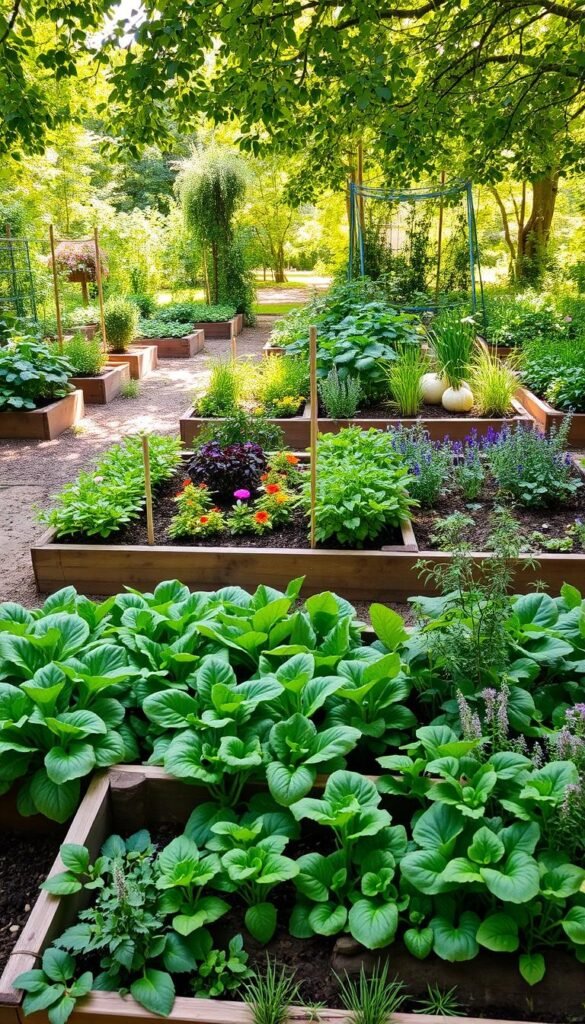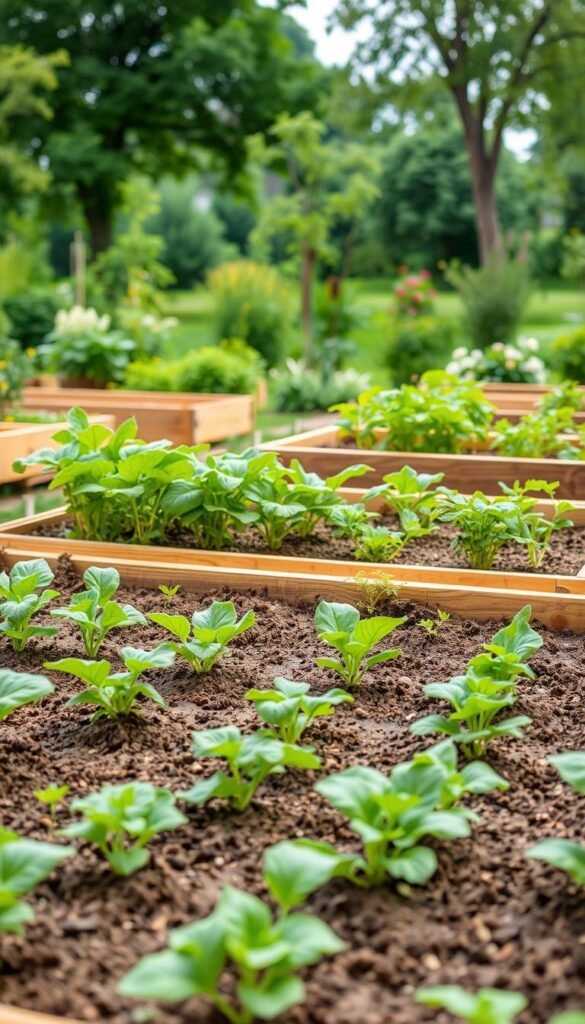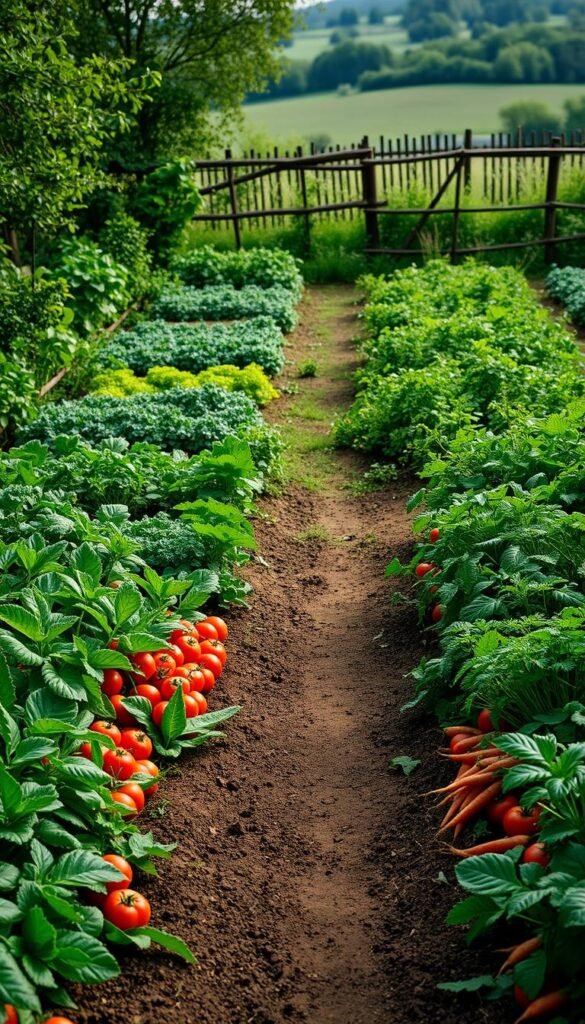There’s nothing quite like biting into a sun-warmed tomato you nurtured from seed. But before those juicy rewards arrive, smart planning turns dirt and dreams into a productive oasis. Whether you’re working with acres or a balcony, how you arrange your plants impacts everything from yields to weekend workloads.
Two popular approaches dominate backyard growing: traditional rows and the space-efficient square foot method. Rows work well for large plots, letting you walk between crops. Compact square foot beds, divided into grids, maximize smaller areas. Both styles succeed when you match them to your sunlight, soil, and lifestyle.
Tomatoes demand 6-8 hours of direct sun – a non-negotiable for most fruit-bearing plants. Tall crops like corn should never shade shorter neighbors. We’ll show how each layout handles these needs while simplifying watering and pest control.
Your available space isn’t just about square footage. Consider how much time you can dedicate to weeding or trellising. Even urban gardeners can enjoy overflowing harvests with the right strategy. Let’s dig into which approach helps your green thumb shine brightest.
Vegetable Garden Layout Design: Mapping Out Rows vs. Square Foot Methods

Choosing how to arrange your crops can make or break your growing season. Let’s break down two proven systems to help you work smarter, not harder.
Rooted in History, Built for Modern Needs
Traditional row gardening began with farm machinery in mind. Those 30-inch gaps between crops let tractors pass through. Home growers often use 12-18 inches between rows – enough room for hand tools but still generous.
Space-Smart Solutions for Small Areas
The square foot approach flips conventional wisdom. Instead of long lines, you’ll plant in dense grids. One zucchini might claim a full square, while radishes pack 16 per section. This method turns a 4×4 bed into a mini food factory.
| Feature | Row System | Square Foot |
|---|---|---|
| Ideal Plot Size | 10+ feet | 4×4 feet |
| Weed Control | Needs frequent tending | Self-mulching |
| Sunlight Use | Tall crops cast shadows | Uniform light exposure |
Both methods demand 6-8 hours of direct sunlight for fruiting plants. The difference lies in maintenance: dense square foot beds block weeds naturally, while rows need regular cultivation.
Your soil quality matters too. Tightly packed squares thrive with compost-rich mixes, whereas traditional rows can handle native earth. Consider your available time – rows forgive occasional neglect, while compact plantings need consistent care.
Planning Your Garden Space with Companion Planting and Raised Beds

Urban growers face unique challenges – but also exciting opportunities. With smart strategies, even a balcony or patio can produce impressive yields. Let’s explore how to combine space-saving structures with plant partnerships that work harder for you.
Maximizing Space in Small Urban Gardens
Raised beds turn cramped areas into thriving edible landscapes. Their elevated design improves drainage and warms soil faster in spring. You’ll spend less time weeding and more time harvesting.
Try these space-stretching tricks:
- Train cucumbers up trellises behind bush beans
- Plant quick-growing radishes between slower broccoli
- Edge beds with fragrant herbs that deter pests
The Role of Raised Beds in Efficient Layout Planning
A 4×8-foot raised bed gives easy access from all sides. Fill it with nutrient-rich soil mixed with compost. This setup works perfectly for square foot garden techniques or creative companion planting.
Proven plant pairs:
- Tomatoes + basil (improves flavor)
- Peppers + carrots (confuses pests)
- Lettuce + chives (shares space efficiently)
Rotate crops yearly in your beds to maintain soil health. Pair deep-rooted veggies with shallow growers each season. With thoughtful planning, you’ll harvest more from every square inch.
Square Foot Gardening: Techniques for a Bountiful Harvest

Transform your growing space into a high-yield paradise using precise planning strategies. This approach turns limited areas into lush, productive zones through smart spatial math and clever resource management.
Calculating Plant Spacing in Each Square Foot
Forget row measurements – your seed packet holds the key. The magic formula works like this: Divide your square’s width (usually 12″) by the recommended spacing between plants. Repeat for length, then multiply the results. Three-inch gaps? That’s 4 plants per side × 4 = 16 per square!
Here’s the twist: Actual squares often measure 11″ due to standard lumber sizes. This slight adjustment makes building beds easier while maintaining planting density. Your radishes won’t mind the tighter squeeze!
Benefits of Denser Planting for Weed Control
Close-knit plants create living mulch. Once leaves overlap, sunlight can’t reach weed seeds. You’ll spend 70% less time pulling invaders compared to traditional methods. Try 9 carrots or 6 lettuce heads per square – they’ll crowd out competition naturally.
Integrating Watering Systems with Garden Grids™
Consistent moisture matters most in tight spaces. The Garden Grid™ system combines drip irrigation with visual spacing guides. Seasonal adjustments become simpler when water lines align perfectly with your planting zones.
Pro tip: Place thirstier crops like basil near grid centers where water concentrates. Drought-tolerant herbs thrive along square edges. This strategic pairing maximizes every drop while keeping roots happy.
Harvesting Your Success: Final Tips and Next Steps
Your journey from soil prep to abundant yields starts with one simple choice: action. Armed with spacing charts and growth strategies, you’re ready to transform any patch of earth – or raised bed – into a thriving food source. Whether you lean toward orderly grids or flexible rows, success lies in adapting these methods to your unique conditions.
Start with a 4×4-foot area to test what works. Track sunlight patterns and soil changes in a notebook – these notes become gold for future seasons. Mix techniques: try dense herb clusters beside trellised beans, blending space-saving smarts with easy access.
Remember, even expert growers tweak their approach yearly. Stunted peppers this summer? Shift their spacing next spring. Battled weeds? Tighten plant groupings. Every challenge sharpens your skills.
Your garden isn’t just plants – it’s a living laboratory. Those first crunchy radishes and fragrant basil leaves? They’re proof you’ve cracked the code. Now dig in, get messy, and let your green thumb lead the way.





